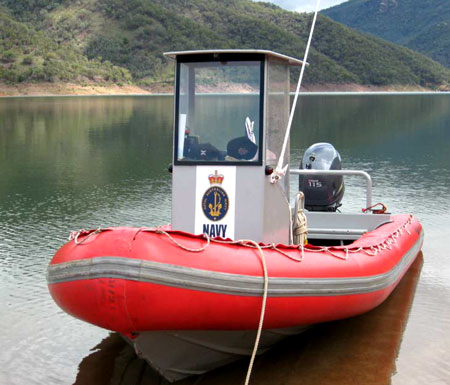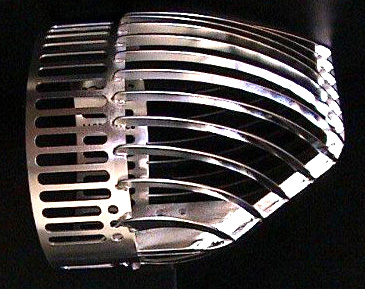Australian Military Fined for Not Using Propeller Guards
Back in February 2010, Oliver Minchin, a 19 year old military cadet at the Australian Defence Force Academy was participating with other cadets in fast water insertion training (jumping in while underway at speed) from a Rigid Inflatable Boat (RIB) on Lake Burrinjuck. Minchin was severely struck by the propeller. His father, a well known senator, stepped down from politics in part to care for his son during his long recovery.
Comcare, Australia’s version of the the United States’ Occupational Safety & Health Administration (OSHA), sued the Defence Force and the Australian Defence Academy for unsafe practices regarding the accident.
On 13 December 2012 Federal Court of Australia decided Comcare v. Commonwealth of Australia. Judge John Griffiths levied a $210,000 AU (Australian dollars) fine against the Australian Defence Force and the Australian Defence Force Academy (ADFA) for not having propeller guards on the boat involved in the Minchin accident. He also awarded Comcare their costs. As of December 2012, one Australian dollar is equal to just a little more than one U.S. dollar. ($1AU = $1.05 US).
Some points of the trial:
- Members of the ADF are Commonwealth employees and deemed to be employed by the Commonwealth and thus are subject to the Occupational Health & Safety Act (OH&S Act).
- BR67 – Admiralty Manual of Seamanship prohibits an engine on a vessel to be engaged when in close proximity to people in the water.
- ABR155 Volume 2 REV 2, RAN Diving Manual – Regulations and Practical Diving Chapters which stated that an engine must not be run or a vessel must not be underway for diving operations if the propeller guard is not fitted.
- The boat, known as Big Red, was a 6.3 meter RIB powered by a 115 horsepower Yamaha outboard. OH&S Act sees the boat and its outboard motor as the “plant” in their terminology (its like the boat is a factory with workers instead of soldiers).

ADFA “Big Red” RIB
- The boat was purchased on 17 May 2002 for a range of activities and training, including water insertion training.
- No risk assessment analysis was performed on the boat before or after its purchase prior to the accident.
- ADFA never gave any thought to installing a propeller guard from date of purchase of the boat till the date of the accident.
- Following the water insertion training, an unscheduled exercise of Fast Boat Runs was suggested. During those runs, Minchin fell overboard and was struck by the propeller. Minchin is still continuing his rehabilitation (now approaching three years later).
- Immediately prior to the water insertion training a Vessel Safety Brief was read. It included the statement, “Keep clear of the Propeller at all times.” They were also told to keep clear of the stern because “the propeller does not house a propeller guard.”
- Immediately prior to the Fast Boat Runs the cadets were told the same safety rules read earlier still applied.
- On January 21, 2010 ADFA issued an Administrative Instruction that included a risk assessment for the Fast Water Insertion exercise. That assessment did not mention the risk of being struck by the propeller.
- Six previous, similar military incidents have since been identified (four prop strikes, one struck by boat when exiting for a fast water insertion, one ran over but no injuries). Some of the prop strikes were props with ring guards.
- The first two incident reports caused the Defence Material Organization (DMO) to complete a safety case study. That study found the Army environment different than the SLSA (Surf Life Saving Australia) environment (near shore life saving) so the SLSA guards were not a viable alternative for the Army. Ring propellers (RingProp) was the most practical solution for the Army. Results of the DMO study were not provided to the ADFA.
- The third incident caused the Army to ask DMO to conduct a review of the risks associated with ring propellers. That review recommended no adjustments be made. The Army adjusted its policies and procedures concerning communication of tasks and supervision of activities.
- Neither the DMO Review nor the Army policy and supervision changes were communicated to ADFA.
- The court found that by the sixth accident the Commonwealth knew there was foreseeable risk of injury from unguarded propellers in water based activities and the training of Defence personnel.
- The court found there was reasonable, practical step available (install full propeller guards).
- Even after the sixth accident the Commonwealth did not install full propeller guards. Only after the Minchin accident, did the Commonwealth install full propeller guards on similar vessels used for similar activities.
- The risk arising from the Commonwealth’s omissions included the risk of serious physical injury, psychological trauma, and death.
- Following the Minchin incident, Comcare issued a Prohibition Notice banning the use of all ADFA RIBs without a full propeller guard. The Prohibition Notice also required ADFA to complete several steps and receive Comcare approval before relaunching the RIBs, including having an independent expert recommend steps to prevent propeller strikes.
- The Commonwealth complied with the Prohibition Notice. They disposed of the boat, undertook a risk assessment on the remaining vessels with outboard motors, and installed PESA guards (the guards used by SLSA boats).
- In mediation, both parties agree Commonwealth broke the OH&S Act on the date of the accident and should bay a fine (pecuniary penalty) of $190,000.
- Comcare said that agreement was not binding on this court. The serious nature of the offenses warrants a higher penalty. Comcare cites no coordinated approach to regulation, policy, or information sharing.
- The Judge said there was not only a foreseeable risk of propeller injuries or death during a Fast Boat Run, there was a very high foreseeable risk. The risk was very highly foreseeable not just due to the inherent risk of a boat without a propeller guard in the exercise, but also from the six similar prior incidents.
- The Judge says it reflects poorly on the ADFA that it did not take action itself by the fourth, fifth, or sixth accident all of which involved the same or similar boats performing the same or similar exercises.
- The Judge referred to previous case in which another judge remarked on the absurdity of the Commonwealth paying itself a penalty. Judge Griffiths says the penalty can have ramifications beyond purely financial considerations (meaning the penalty may cause Defence to change its ways).
- Judge Griffiths feels that promised additional communication channels between Comcare and Defense were insufficient (Defence said it would circulate Comcare report findings but made no policy changes to assure increased communication).
- Taking all factors into account, Judge Griffiths found the mediated settlement amount of $190,000 insufficient and increased it to $210,000 AU plus Commonwealth must pay Comcare’s costs in this matter.
The Judge’s full decision is available from the Australian Legal Information Institute.
A February 2012 New South Wales (NSW) Transport Roads and Maritime investigation report previously found a propeller guard should have been fitted on the boat unless there was a compelling reason not to do so.
We (PGIC) find this case very interesting. Basically, the Australian version of OSHA forced their military to use propeller guards because open propellers are dangerous near people (employees) in the water. The corollary was not addressed (are open propellers dangerous to civilians in the water and should recreational boats have propeller guards).
We also found it interesting ADFA (Australian Defence Force Academy) selected the PESA guards used by SLSA (Surf Life Saving Australia). PESA guards use a relatively tight spacing of flattened vanes to reduce drag. The vanes arch from the leading edge of the drive to a slotted ring around the prop. At one time PESA guards were banned from surf lifesaving competitions because they performed too well (had much less drag, thus higher boat speeds than competitors).SLSA guards used to be qualified with a fixture that looked like a tootsie pop. You just try to jam the ball end of the stick through any hole in the screen. If it goes in, the guard is not acceptable. Compare that test to the current USCG propeller guard protocol still under development that will cost thousands of dollars to run. We encourage the use of practical, easy to administer go-no-go qualification tests when possible.
We encourage the U.S. boating trade media to cover this case

A friend has severe injuries from propellor accident, is there a petition I can sign to bring in guards?
I see you are in the UK. We would encourage you to join the existing movement for propeller safety there. A young boy there (Cian Williams) and his mother have been speaking out for propeller safety. They have a Facebook group at Put Cages on Boat Propellers:
https://www.facebook.com/groups/516900968325066/
Charlie Hutton’s family and friends have been raising funds for the RNLI in his memory:
https://www.facebook.com/pages/Charlie-Hutton/501640846520006
http://issuu.com/simonhutton/docs/charlie_booklet_aw_nocropmarks
Maurice Abrahams near Whitfield has also been speaking out to the press about propeller safety issues.
If you contact any of those three groups, I am sure they can find some way for you to become involved. If you just want to “sign a petition” joining Cian’s group helps make a statement.
Thanks for your interest in propeller safety.
gary polson